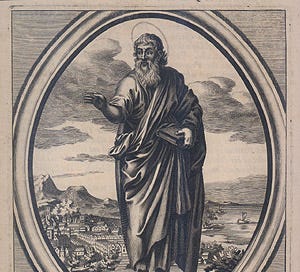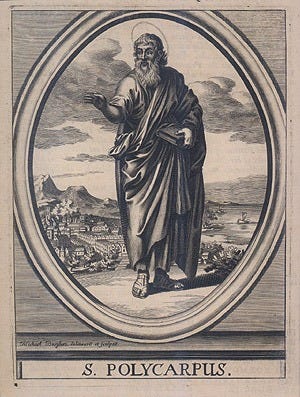
When Did Christians Start Celebrating Easter?
Its origin is apostolic, tied to the Passover and rooted in the Gospel.
Early Christians celebrated Good Friday and Easter at least as early as the 100s and probably much earlier. This celebration, called Pascha, was rooted in the Passover narrative of Exodus 12, with Christ glorified as the Passover lamb. This paschal typology was first articulated in the New Testament and later developed by early church fathers.
Yet today many assume that Easter is a late addition to Christianity, one inscrutably linked to pagan rituals. And even if that is not you, I suspect that you may not have heard much about the origins of Easter or Pascha before.
To help fill that gap in your knowledge, this article outlines the early history of Pascha through Scripture, early Christian texts like Melito of Sardis's Peri Pascha, and the historical debates over Pascha's date, resolved at the Council of Nicaea. I by no means aim to be comprehensive, but simply aim to share a few important parts of the Easter story amongst early Christians with you.
Pascha in early and earliest Christianity
The earliest non-biblical source I am aware of that explicitly speaks of celebrating Pascha is Melito of Sardis in his Peri Pascha (c. 150 AD). Others like Origen of Alexandria also wrote their own Peri Pascha (c. 220 AD), alluding to the Christian celebration. And it becomes something of a theological commonplace to speak of the Pascha in these early centuries.
Yet the origins of why Christians focus so much on Pascha, or what we call Good Friday and Easter today, begins in the Bible itself. Paul, for example, states in 1 Corinthians 5:7, "For Christ, our Passover lamb, has been sacrificed."
Origen following Paul's lead writes, "That the passover still takes place today, that the sheep (πρόβατον) sacrificed and the people come up out of Egypt, this is what the Apostle is teaching when he says: For Christ, our paschal lamb, has been sacrificed. Let us, therefore, celebrate the festival, not with the old leaven, the leaven of malice and evil, but with the unleavened bread of sincerity and truth (1 Cor. 5:7–8)" (Peri Pascha 3.10–19). A little later Origen will conclude that Passover lamb has its typological fulfillment in Christ.
Importantly, the word Passover in Greek is pascha which sounds like the verb to suffer (paschein). Hence, the Passover also carried strong verbal and mental connotations of the Passion of Christ.
This theological reflection did not mean all Christians argued for the Pascha based on an etymological fallacy! Many Christians knew perfectly well that the word Passover comes from the Hebrew term pesach.
For example, Origen, ever the master of the literal sense of Scripture, explains, "And should one of us in conversation with Hebrew people too rashly mention that the passover takes its name from the suffering of the Savior, he would be ridiculed by them as one totally ignorant of the meaning of the word" (Peri Pascha 1.30–39). He knew the Hebrew etymology, but pointed to the theological or liturgical use of Pascha as pointing to Christ's suffering as an important part of the Christian tradition.
Thus, reflective Christians connected the verbal paschein to the Passion of Christ because of its theological connections.
John, the Paschal Gospel
Among all the New Testament books, the Gospel of John most clearly shows how Christ is our Passover Lamb. Consider the following:
The Gospel of John mentions three Passovers (John 2:13; 6:4; 11:55–12:1), with some scholars suggesting a possible fourth in John 5:1, though the feast there is unspecified.
Jesus is called the Lamb of God (John 1:29, 36), and he dies when the Passover lambs are slaughtered (John 19:14, 31).
The hyssop that gave Jesus sour wine parallels the hyssop that carried the blood in Exodus 12 (John 19:29).
The detail of Jesus's bones not being broken parallels the Passover lamb, whose bones may not be broken (John 19:36; Exod 12:46).
The seven "I am" statements in John's Gospel parallel God's revelation of His name in Exodus 3:14, who is the God that delivers Israel through the Passover from Egypt.
On the latter point, simply consider the sevenfold I AM statements of Jesus:
"I am the bread of life" – John 6:35
"I am the light of the world" – John 8:12
"I am the gate/door" – John 10:9
"I am the good shepherd" – John 10:11
"I am the resurrection and the life" – John 11:25
"I am the way, the truth, and the life" – John 14:6
"I am the true vine" – John 15:1
These statements, with their meaning-laden number (seven), draw us to see Jesus alongside the burning bush of Exodus 3.
Further, the Book of Revelation speaks of Christ regularly as a lamb slain for the sins of the world (Rev 5:6-14; 6:1, 16-17; 7:9-17; 12:11; 13:8; 14:1-10; 15:3; 17:14; 19:7-9; 21:9-27; 22:1-3). John here uses the lamb imagery in connection with Passover imagery.
One last reason may explain why John focused on the Passover, and that has to do with his role as a priest and perhaps as a high priest. Polycrates (c. 190 AD) calls John a high priest ("wearing the breastplate"), which might explain why Caiaphas's household recognized John and let him into the trial of Jesus in John 18:15-16—"that disciple was known to the high priest," but Peter was not (EH 5.24).
Polycrates was the eighth in line of bishops in Ephesus, where John lived and was buried about one hundred years before he made his statement. Polycrates was sixty-five when he wrote, and so that means he was born around 130 AD or thirty-five years after John died in Ephesus. Since his family members (kinsmen were bishops before him), it stands to reason that he might reasonably have insight into the biography of John.
In other words, if John was a priest or even a high priest, he would have known much about sacrificing lambs and particularly about the Passover Lamb. The theological significance would not have been missed for him that Jesus was "the Lamb of God, who takes away the sin of the world!" (John 1:29).
And according to Irenaeus of Lyon, a disciple of Polycarp of Smyrna: "Polycarp had always observed [Pascha], together with John the disciple of our Lord and the other Apostles with whom he had lived" (EH 5.24). In other words, Polycarp asserts that the apostles themselves celebrated Pascha, what we in the English speaking world call Easter (although virtually everyone else calls it Pascha).
Pascha in Asia and Rome
Given this apostolic origin, it is small wonder that during the 100s, the most important day of the year for the Christian calendar was Pascha. It was so important that bishops called councils and whole regions of the world debated which day to celebrate Pascha on (EH 5.23).
For example, those in Asia Minor celebrated it on the 14th of Nisan, while those in Rome wanted to ensure that Pascha would occur on a Sunday, the Lord's Day, and not simply whatever day the 14th fell on.
According to Irenaeus, Polycarp of Smyrna in the 150s travelled to Rome to mediate this divide in the church as to when to celebrate the Lord's Pascha:
"when the blessed Polycarp sojourned in Rome in the time of Anicetus, although they had small difficulties about certain other matters, they immediately made peace, having no desire for strife among themselves on this outstanding question. Neither was Anicetus able to persuade Polycarp not to observe it, inasmuch as Polycarp had always observed it, together with John the disciple of our Lord and the other Apostles with whom he had lived; nor, on the other hand, did Polycarp persuade Anicetus to observe it, for Anicetus said that he was obliged to cling to the practice of those who were presbyters before him." (EH 5.24)
Despite these differences, Polycarp and Anicetus made peace, and the churches thrived. The Asians celebrated Pascha on the 14th of Nisan, while the Romans chose the Lord's Day (Sunday).
Another Asian bishop, Polycrates of Ephesus, likewise maintained the practice of celebrating the Pascha on the 14th of Nisan in the 190s. And this tradition carries on throughout the 200s. It is worth quoting a long passage by Polycrates who gives further context for the celebration of the Pascha:
"We, therefore, keep the precise day, neither adding nor taking away, for even in Asia great luminaries have fallen asleep, which shall rise on the day of the coming of the Lord, when he comes with glory from heaven and shall seek out all the saints, Philip of the twelve Apostles, who have been sleeping in Hieropolis, and two of his daughters who had grown old as virgins, and another daughter of his who lived in the Holy Spirit and rests at Ephesus. Furthermore, there is also John, who leaned on the breast of the Lord, and was a priest wearing the breastplate, and a martyr, and teacher. This one rests at Ephesus.
"Then there is also Polycarp in Smyrna, both bishop and martyr; and there is Thraseas, both bishop and martyr, from Eumenaea, who rests at Smyrna. And why need I mention Sagaris, bishop and martyr, who rests in Smyrna, and also Papirius the blessed and Melito the eunuch, who lived entirely in the Holy Spirit and lies in Sardis awaiting the visitation from heaven when he will rise from the dead? All these observed the fourteenth day of the Passover according to the Gospel, never deviating, but following according to the rule of the faith.
"And I also, Polycrates, do so, the least of you all, according to the tradition of my kinsmen, some of whom I have followed. Seven of my kinsmen were bishops, and I am the eighth. And my kinsmen always observed the day when the people put away the leaven. So, my brethren, having lived sixty-five years in the Lord and having associated with the brethren from the entire world and having read all holy Scripture, I am not frightened at what is threatened us, for those greater than I have said, 'We ought to obey God rather than men.'" (EH 5.24)
First, note how wide-spread the practice was. Second, note that Polycrates positions their celebration in accordance with the Gospel—almost certainly the Gospel according to John, given that John was buried in Ephesus where Polycrates was bishop; and because of the paschal emphasis in John's Gospel.
Like Polycarp, Polycrates also locates the origin of the Pascha with the apostles, not in some post-apostolic creation. Hence, were we to be credulous of this claim (and I am), then it follows that Pascha was celebrated during the lifetime of the apostles. What we call Easter through an accident of the English language has thus been celebrated for about 2,000 years among Christians.
Although the date of celebration was debated, we should note that this debate arose because of how important the death and resurrection of Jesus was to Christians. We must not miss the essential point. Pascha by its name was always tied to Scripture (Passover), Christ (our Passover lamb), and Christian worship of the lamb who is worthy of all praise.
In 325, the Council of Nicaea provided the beginnings of unity on the day of celebration. While it took many more years, eventually, through much disagreement, Christians began to celebrate Easter on Sunday in the East rather than on whatever day the 14th of Nisan fell.
Is Pascha Identical to Modern Easter?
At least for the quartodecimans, Pascha both included what we might call Good Friday and Resurrection Sunday because it remembers Christ, our passover lamb who suffered for us, and yet it was commonly celebrated on Sunday, the day of the Lord's Resurrection.
Alistair Stewart-Sykes writes, "The Quartodeciman Pascha comprised what we would know both as Good Friday and as Easter, for in keeping with the Johannine tradition according to which the crucifixion was itself the manifestation of God's glory, and in keeping with the Jewish liturgical tradition of a single celebration of the Passover, the Pascha was a single festival which commemorated both the passion and the resurrection." (2001: On Pascha, 18)
In most countries today, Easter goes by the name of Pascha or some variant. It was only an accident of the English language and an inscrutable English impulse to rename things that it became known as Easter in English speaking countries. According to Bede, Christians called Pascha Easter because it was celebrated in the fourth month of the year, known to the early English as osturmonath. Ostur became Easter, and thus Pascha was renamed based on the month it was celebrated in. For a discussion of the odd history of the name of Easter, check out the video podcast at the end of the article.
Any notion of it being connected to Ishtar—a frankly impossible connection given that Pascha and its origins have no similarities to Ishtar—or other medieval pagan myths falls by the wayside given the evidence cited above.
Easter is Pascha, although Christians came to celebrate Pascha on Resurrection Sunday and divide Holy Friday into an earlier phase of Holy Week. The name Pascha and its association with the passion of Christ meant that the celebration included the death and resurrection of Christ, which remains true today even though Easter, for most of us in the West, points to the resurrection while Good Friday points to the cross.

















Very helpful Wyatt. Did the early church continue to “sacrifice” lambs for paschal? A “look back” if you will? One of the criticisms of dispensationalism eschatology is the discomfort critics have with a resurgent Jewish sacrificial system.